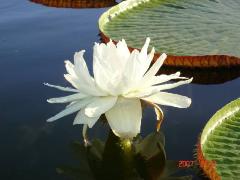|
|
||
|
In 2004 I walked into the Panaewa Rainforest Zoo, Hilo, Hawaii,
the first time. I saw this large waterlily in the pond near
the front entrance. Its huge leaves reached 3 feet (91 centimeters)
in diameter and the blooms were as large as 6 inches (15 centimeters)
across. Its leaf rims rose out of water several inches in height.
Without a doubt, I told myself, it must be the queen of the waterlily
world. I learned later that it originated in Amazonia in Brazil.
It took English horticulturists many years to cultivate it and
for it to produce its first flower. The grower named it after
Queen Victoria. Soon we found out two things. First, it was rather dangerous to get near the Victoria. Its one-inch long sharp spines covered the plant stems and undersides of the pads. Working near the plant for a few minutes, our waterproof suits were no longer waterproof. The spines would puncture through our skin without any problem. Maybe that is the way the plants protect themselves from piranhas in Amazonia. The second thing we found was that the Victoria is supposed to be an annual plant. In other words, it dies in wintertime. Our Victoria was four years old and still alive. “Wow,” Roger and I said to each other. “We have something special here.” We gave the plant the name “Old Faithful.” We transplanted the Victoria to a 20-gallon pot and added more fertilizer. Its pads reached 46 inches (117 centimeters) in size. Its flowers reached 8 inches (20 centimeters) in size. 2007 was a cold winter. I took the plant home and kept it alive through the winter in my warm-water pond. 2008 was a great year. Old Faithful gave us more flowers than ever. More and more people traveled many miles just to see it. |
||
| 2009 was one of the coldest winters ever in Hilo, 55 degrees F (13 C). Old Faithful kept shrinking smaller and smaller. In January, when its pads diminished to 6 inches (15 centimeters) in diameter, I took it home and put it in my heated pond. It stayed alive but never recovered. April 15, 2009, the last tiny pad melted away. Old Faithful was gone. She lived over seven years. It made her one of the longest living Victorias on record. Maybe it is because of the nice warm weather of Hilo or because of our TLC, she lived seven times longer than most. She made us realize that even everything has its time and limit but, once in a while, a miracle does happen. | ||

